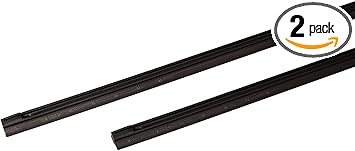The Michelin winter blades at Costco have been fine for winter use here, and that's at about 4000ft altitude and less than a dozen miles from Mt. Bachelor ski area.
The arguments about measuring/specifying blade length in inches or mm are moot. A quarter inch (6.4mm....) difference in blade length translates to one eighth of an inch at each end installed. Can you really tell that difference while driving and the wipers are running?
A slightly shorter blade might offer a bit more specific pressure at the blade edge. A slightly longer blade less, plus the need to curve more at the outer end of the passenger-side blade so it stays in full contact with the curved glass.
Running the defroster hard might seem to help the wipers work better clearing snow, but... That risks having wipers frozen to the glass when you return to the refrozen car. OK to prop the wiper arms off the glass when you park in that condition making it possible to clear the glass surface with a scraper without damaging a blade edge that's frozen to the glass.
Do your blades a huge favor and completely clear the ice and snow from the glass before you run the wipers. The blade suffers when you ask it to grind and drag on ice rather than wipe the glass. I keep both a 10" hand scraper and a longer brush/scraper in the car for the duty. Judicious use of that defroster helps manage ice formation quite a bit.
I have a big bottle of Rain-X that gets used in winter to make the glass a little more hydrophobic. It works well until dirt gets added to the snow mix. There are certainly better glass treatments available these days. I'll do more research when the bottle I have now runs out.
I haven't yet seen a need to use any of the miracle winter washer fluids like Rain-X yet. Does anybody have results to share? Regardless, do make sure you use a non-freezing fluid in the washer tank. Freezing and dirt are the killers of washer pumps and spray nozzles. The washer tank really needs a fine strainer in the neck under the fill cap.
Make the effort to keep the glass clean. Our car lives in the relative comfort of a climate-controlled garage at home, so actually cleaning the glass isn't at all inconvenient.
Discourage passengers (and drivers...) from wiping the inside of the glass to clear fog, especially with bare hands. Fine if they do it I guess, but this forces another glass-cleaning. Better to use one of the better anti-fog glass treatments if this is a chronic need, and keep a few microfiber towels handy for those who just can't seem to help themselves.
The AC is usually pretty good with reducing humidity in the cabin, but only after the cabin temp comes up to at least 40ºF or so with the heater. From that point the AC evaporator can be the coldest contact surface and will condense most of the moisture for you.
A neighbor has an all-you-can-eat deal with a local car wash. For about $40 a month, he can get an exterior wash and blow-dry whenever he feels the need, and that includes an undercarriage blast to clear cinders/sand and the deicer slurry pre-treatment that's used on roads here instead of "salt". The place is open whenever temps are above about 30º in the daytime. I'm generally not a fan of commercial car washes and all the scratching they do to paint, plus I have hot water wash-bay capability in the workshop. But for the less-obsessed and -equipped, it's a great option for keeping the car and the glass clean and ice-free.






